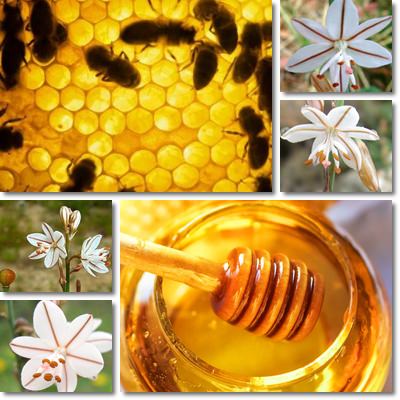Asphodel honey is a monofloral variety of honey made from the nectar and pollen of asphodel flowers. It is an artisanal honey produced primarily from asphodel species native to the Mediterranean region. Sardinian asphodel honey is a prized variety, greatly enjoyed for both its flavor profile and therapeutic properties. The raw honey concentrates unique natural compounds with a variety of health effects such as preventing hypoglycemia and fatigue, soothing digestive upset and sore throat, calming cough or managing gastritis.
What is asphodel honey made from? The variety is a floral honey, or flower honey. Honey bees collect the nectar and, incidentally, the pollen of asphodel flowers and mix them with special enzymes they secrete themselves, thus producing honey. The most famous variety is Sardinian asphodel honey and it’s made from species of the flower growing in the island of Sardinia, Italy. Species may include: white asphodel (Asphodelus albus), summer asphodel (Asphodelus aestivus), branched asphodel (Asphodelus ramosus), Asphodelus macrocarpus, pink asphodel (Asphodelus fistulosus) etc. In theory, where there are sufficient asphodel flowers and honey bees are present, asphodel honey can be made.

Can you be allergic to asphodel honey? Yes, you can. If you are allergic to asphodel flower pollen, then you are allergic to the honey as well because it contains pollen in addition to the flower nectar. In those of us with an overactive immune system, harmless elements like pollen (or dust and others) are seen as threatening by our immune system and it generates a strong immune reaction against them. This reaction can engender inflammation so serious that it can disrupt normal breathing, hence the reason it is important for us to avoid allergens at all costs. If you are allergic to enzymes secreted by honey bees, then you are allergic to asphodel and all honeys, as well as other honey bee products such as bee bread, royal jelly, propolis etc. because they are all made using enzymes secreted by honey bees. If you have had past allergies to asphodel or other honeys, then it is best to continue avoid honey and other bee products.
What does asphodel honey look like? The variety has a clear, light golden color with a warm tone. Crystallized asphodel honey forms fine crystals and turns a paler, opaque light yellow, almost whitish color.
What does asphodel honey taste and smell like? The honey is particularly sweet, but light and only slightly acidic. It has a warm aromatic profile and includes light floral and, to a lesser extent, herbal notes. Sweet vanilla or spicy fennel aromas are also reported. Depending on where the honey is produced, its flavor profile may vary slightly and include different aromatic notes. This is because nectar from other flower species may be present in the monofloral honey, although in smaller amounts compared to the main flower nectar which is asphodel.

What is asphodel honey good for? Considering its nutritional composition and therapeutic effects, this particular variety of honey can be good for the gastrointestinal and respiratory systems, promotes skin health and has a beneficial effect on energy levels. Here are 7 interesting properties, uses and health benefits of raw asphodel honey:
1) Good for respiratory infections. Like all honeys, asphodel too has a natural antibacterial action as a result of its content of hydrogen peroxide, antioxidants with antimicrobial and anti-inflammatory action, but also acidic pH and low moisture content. All of these elements suppress bacteria growth and actively help reduce bacteria numbers. Research shows some honeys are effective even against antibiotic-resistant strains of bacteria such as Escherichia coli or Staphylococcus aureus, in the right concentrations and preparations.
Honey has the strongest effect when it comes in direct contact with pathogenic microorganisms, hence the reason it is employed as a complementary treatment for upper respiratory tract infections. Eating the raw, unprocessed, unheated honey is supposed to not only help reduce bacterial load, but also exert an anti-inflammatory and calming action, promoting the healing of mucous membranes such as the throat lining.
2) Calms cough and soothes a sore throat. Eating raw asphodel honey helps calm cough and soothe sore throat irritation by forming a sort of protective coating over the throat lining, allowing it to heal. At the same with its calming, soothing action, the honey acts like a local anti-inflammatory and may help reduce bacteria numbers, further improving the condition. When I have a sore throat and cough, I eat a tablespoon of raw honey (be it acacia, linden, sunflower or asphodel) several times a day, and avoid eating anything else for at least an hour afterwards to give the honey time to exert its beneficial action.
3) Wound healing benefits. Due to its antibacterial action, asphodel and honey in general has been proven effective in improving wound healing time. Of course, this doesn’t mean we can just apply the raw honey on a wound. The antibacterial action of honey can vary greatly from jar to jar, the honey may be contaminated with various microorganisms (yeasts, bacteria, molds), not to mention that the antibacterial elements in most honeys are often not at a concentration that can effectively promote wound healing. So see your doctor for adequate treatment if you have an injury or open wound.
4) Digestive benefits. Eating asphodel honey is said to help improve overall digestive function. The natural sugars it contains, oligosaccharides to be exact, are a food source for the good bacteria in our intestines and it is this prebiotic effect that is said to help improve digestion and, for some, help treat constipation.
5) Gastritis management. Honey taken on an empty stomach is known to calm digestive upset and even help with the management and treatment of gastritis by exerting a soothing action that calms the irritation of the stomach lining. Moreover, certain honeys contain special elements that actively encourage the regeneration of damaged stomach tissue, hence the use for gastritis and even stomach ulcers treatment. However, because a good diet is a vital part of gastritis treatment, read more about what foods to eat and to avoid for gastritis.
6) Skin benefits. Used topically, asphodel honey calm help calm skin irritation and stop the face from being oily. I find it to be a gentle, but efficient astringent, helping control excess sebum production. It also exerts a gentle exfoliating action, unclogs pores and efficiently cleanses the face, helping reduce acne breakouts. Being a light honey, it can help with uneven tone, provided it is used consistently and you are not allergic to it.
7) Nutritious with tonic, energizing effects. Asphodel honey contains small amounts of various essential nutrients such as vitamin C, vitamins B5, B2, B3 and B9, potassium, magnesium, calcium and others (B Vitamins and Folate: Chemistry, Analysis, Function and Effects). Moreover, it also contains small amounts of amino acids, pollen particles, natural sugars and other elements of nutritional value. All of these elements combined give the honey its tonic, energizing properties and anti-fatigue and anti-hypoglycemic action.
Other benefits: calming on the nervous system, antispasmodic action, purifies blood. Various other benefits of asphodel honey have been reported and are derived from traditional medical practices. Eating the honey is said to reduce muscle spasms, improve muscle cramps, calm the nervous system, exert a diuretic action and boast hepatoprotective effects.
Conclusion
Overall, asphodel honey is a great natural sweetener with a tonic action and good nutritional value. Consumption benefits the respiratory and digestive systems and promotes skin health. What makes asphodel honey healthy, in addition to its natural antibacterial, antioxidant and soothing properties, is the fact that it is, for the most part, produced in Italy, a country with a long history of clean honey production, known for its raw, unaltered and unprocessed artisanal honeys.
